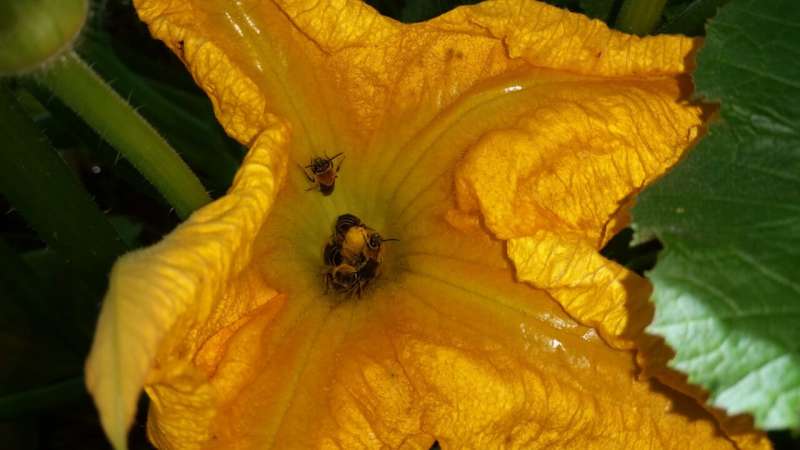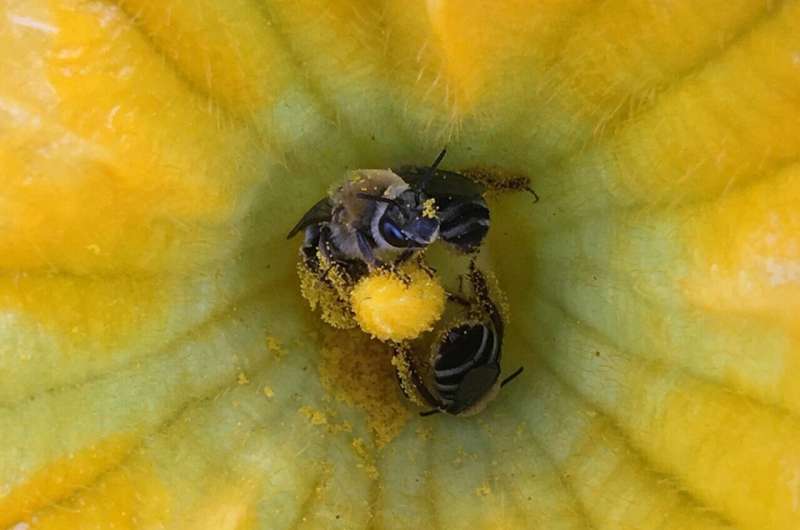This article has been reviewed according to Science X's editorial process and policies. Editors have highlighted the following attributes while ensuring the content's credibility:
fact-checked
peer-reviewed publication
trusted source
proofread
Squash bees flourish in response to agricultural intensification

While pollinator populations of many species have plummeted worldwide, one bee species is blowing up the map with its rapid population expansion. The key to this insect's success? Its passion for pumpkins, zucchinis, and other squashes, and the massive increase in cultivation of these crops across North America over the last 1,000 years.
A new study led by Penn State found that the squash bee (Eucera pruinosa) has evolved in response to intensifying agriculture—namely squashes in the genus Curcurbita. Published in the Proceedings of the National Academy of Sciences, the research is the first to demonstrate the role of agriculture as an evolutionary force acting on a wild insect pollinator and may have implications for food security.
"When we think of insects benefiting from and adapting to widespread agriculture, we tend to think of pests such as certain kinds of moths, flies and beetles," said Margarita López-Uribe, Lorenzo L. Langstroth Early Career Professor and Associate Professor of Entomology. "But the impact of agricultural intensification on the evolution of beneficial pollinators is poorly understood. We found that agriculture facilitated increases in population size of this squash bee, and this may be the case for other insect pollinators, as well."
López-Uribe noted that the study is the first to identify adaptive processes of an insect pollinator in response to human agricultural practices. This study demonstrates that human agriculture in North America has had a profound impact on the evolutionary history of an insect that is an essential pollinator of squash crops, she said.
"Pollination is such an important process that impacts so much of the food we eat. Understanding how humans have and continue to impact that process and pollinators—through agriculture, urbanization and in other ways—is key to ensuring we maintain food security," said Sam Scheiner, program director at the U.S. National Science Foundation. "This research highlights how domesticating plants can have important indirect effects on the organisms that pollinate those plants."
Historically, the squash bee's (Eucera pruinosa) primary source of pollen was the wild buffalo gourd (Curcurbita foetidissima), a baseball-sized squash that grew in the deserts of Mexico and the southwestern United States. As one of the "Three Sisters," which includes corn and beans, squash was an important crop of Indigenous Peoples in the Americas, and about 5,000 years ago, Indigenous Peoples of the Eastern Woodlands began to domesticate a relative of C. foetidissima, called C. pepo. Widespread cultivation of the resulting crops—which included pumpkins, squash, and gourds—began later, about 3,000 years ago, and was intensified around 1,000 years ago with the introduction of maize to the agricultural systems of North America.
"By planting squash all over North America, humans created habitat for the squash bee, and that allowed its population to explode," said López-Uribe. "Today, the squash bee occurs throughout the United States and southeastern Canada—far beyond the range of its original food source."

To investigate the evolution of the E. pruinosa bee in response to the intensification of Curcurbita agriculture, the team sequenced the bee's genome, examined its genetic structure—or the amount and distribution of genetic diversity within and among the bee's various populations—and searched for signatures of adaptation. Decreases in genetic diversity, explained López-Uribe, can indicate 'selective sweeps'—or the process by which new beneficial mutations increase in frequency and become fixed.
Next, the team developed a novel algorithm to estimate the bee's migration and effective population size—or breeding population size—across populations.
The researchers found that the bee's transition from wild host plants in deserts to temperate agricultural habitats was associated with selective sweeps resulting in substantial reductions in genetic diversity in some parts of the genome.
"Nearly 20% of the bee's genome appears to be linked to these sweeps," said López-Uribe.
Particularly linked to these selective sweeps were changes in genes associated with chemosensation—or the translation of chemical signals from the environment to neurological signals that can be interpreted by an organism. In the case of the squash bee, chemosensation refers to its ability to interpret odor compounds produced by flowers.
"Domesticated Curcurbita plants produce floral blends that are simpler than those of the wild Curcurbita plant," said López-Uribe. "It is likely that E. pruinosa adapted to a new sensory environment in agricultural habitats, which enabled it to expand its range and significantly increase its population size."
More information: Pope, Nathaniel S. et al, The expansion of agriculture has shaped the recent evolutionary history of a specialized squash pollinator, Proceedings of the National Academy of Sciences (2023). DOI: 10.1073/pnas.2208116120
Journal information: Proceedings of the National Academy of Sciences
Provided by Pennsylvania State University



















